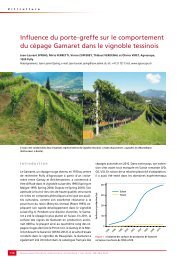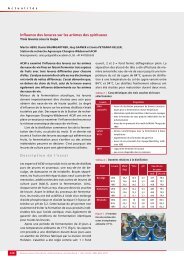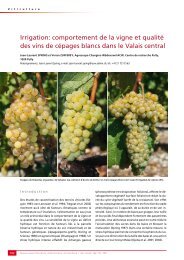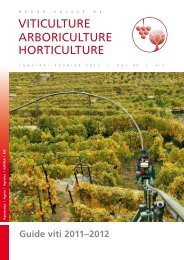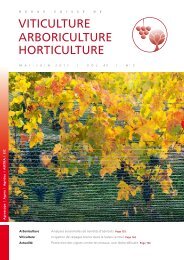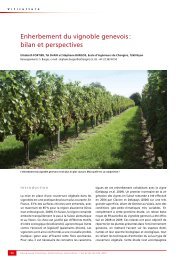Télécharger le PDF - Revue suisse de viticulture arboriculture ...
Télécharger le PDF - Revue suisse de viticulture arboriculture ...
Télécharger le PDF - Revue suisse de viticulture arboriculture ...
You also want an ePaper? Increase the reach of your titles
YUMPU automatically turns print PDFs into web optimized ePapers that Google loves.
Summary<br />
Aptitu<strong>de</strong> to processing of<br />
app<strong>le</strong> fruits varieties<br />
A good know<strong>le</strong>dge about the<br />
raw material characteristics<br />
and its effect on the final product<br />
is necessary to improve<br />
the quality of processed fruits.<br />
The aim of the present work<br />
is to study the impact of app<strong>le</strong>s<br />
initial quality, and more<br />
particularly their mechanical<br />
properties, on their capacity<br />
to be processed in vacuum<br />
cooked fruits. In that or<strong>de</strong>r,<br />
1 of the factors known to<br />
contribute to variations in fruit<br />
texture is tested: the choice of<br />
cultivar. The results show that<br />
the initial fruit firmness is not<br />
related to its ability to be<br />
processed, as the most resistant<br />
app<strong>le</strong>s to the vacuum<br />
cooking were not the firmest<br />
ones. The varietal effect seems<br />
to be the most important<br />
factor. Two app<strong>le</strong> cultivars<br />
appeared to be particularly<br />
well adapted to this type of<br />
process: Royal Gala and Cripps<br />
Pink. Unlikely, in spite of its<br />
high firmness <strong>le</strong>vel, the Granny<br />
Smith cultivar did not resist to<br />
the thermal treatments applied<br />
during the process.<br />
Key words: app<strong>le</strong>, texture,<br />
se<strong>le</strong>ction, processing.<br />
Zusammenfassung<br />
Aptitu<strong>de</strong> <strong>de</strong>s variétés <strong>de</strong> pommes à la transformation industriel<strong>le</strong> | Arboriculture<br />
Eignung <strong>de</strong>r Apfelsorte zur<br />
industriel<strong>le</strong>n Verarbeitung<br />
Der Einfluss auf die Qualität <strong>de</strong>r<br />
verarbeiteten Früchte verlangt<br />
gute Kenntnisse <strong>de</strong>r Rohstoffe<br />
und <strong>de</strong>r Auswirkungen, die<br />
diese auf das Endprodukt<br />
haben können. Das in diesem<br />
Artikel vorgestellte Ziel <strong>de</strong>r<br />
Arbeit ist es, die Auswir kung<br />
<strong>de</strong>r Qualität <strong>de</strong>r Äpfel und<br />
beson<strong>de</strong>rs ihrer Textur auf ihre<br />
Fähigkeit in Früchte <strong>de</strong>r<br />
5. Kategorie (geschälte und<br />
dann im Vakuumverfahren<br />
gegarte Früchte) verarbeitet<br />
zu wer<strong>de</strong>n, zu studieren. Zu<br />
diesem Zweck sind zwei Auswirkungen,<br />
die stark mit <strong>de</strong>n<br />
Variationen <strong>de</strong>r Fruchtstruktur<br />
verbun<strong>de</strong>n zu sein scheinen,<br />
getestet wor<strong>de</strong>n: Die <strong>de</strong>r Sorte<br />
und die <strong>de</strong>r längeren Lagerung<br />
in modifizierter Atmosphäre.<br />
Die Studie zeigt, dass die Wahl<br />
<strong>de</strong>r für <strong>de</strong>n Prozess geeigneten<br />
Sorte wesentlich ist, um ein verarbeitetes<br />
Produkt von befriedigen<strong>de</strong>r<br />
Qualität zu erhalten. Erstaunlich<br />
ist, dass die Festigkeit<br />
<strong>de</strong>r frischen Früchte nicht eine<br />
Garantie für das Verhalten<br />
während <strong>de</strong>s Verarbeitungsablaufs<br />
ist. So war zum Beispiel<br />
<strong>de</strong>r Granny Smith gegenüber<br />
al<strong>le</strong>n Erwartungen überhaupt<br />
nicht für diese Verarbeitung<br />
geeignet, trotz <strong>de</strong>r hohen<br />
ursprünglichen Festigkeit. Die<br />
am besten geeigneten und<br />
vielversprechen<strong>de</strong>n Sorten sind<br />
Royal Gala und Cripps Pink.<br />
Längere Lagerung scheint al<strong>le</strong>rdings<br />
al<strong>le</strong> Sorten Äpfel empfindlich<br />
zu machen und somit<br />
auch weniger resistent beim<br />
Garen im Vakuumverfahren.<br />
Dennoch scheint wie <strong>de</strong>rum<br />
die Apfelsorte Royal Gala<br />
besser die Lagerung zu überstehen<br />
und dabei eine akzeptab<strong>le</strong><br />
Textur zu bewahren.<br />
Riassunto<br />
Attitudine <strong>de</strong>l<strong>le</strong> varietà<br />
di me<strong>le</strong> per la trasformazione<br />
industria<strong>le</strong><br />
La gestione <strong>de</strong>lla qualità <strong>de</strong>lla<br />
frutta trasformata necessita<br />
una buona conoscenza <strong>de</strong>lla<br />
materia prima e <strong>de</strong>l suo impatto<br />
sul prodotto finito. Questo<br />
articolo analizza l’impatto <strong>de</strong>lla<br />
qualità <strong>de</strong>l<strong>le</strong> me<strong>le</strong> e in particolare<br />
<strong>de</strong>lla loro tessitura, sull’attitudine<br />
alla trasformazione in<br />
prodotti di V gamma (frutti<br />
sbucciati e poi cotti sotto<br />
vuoto). Per questo motivo, è<br />
stato testato uno <strong>de</strong>i fattori<br />
fortemente <strong>le</strong>gato al<strong>le</strong> variazioni<br />
<strong>de</strong>lla tessitura <strong>de</strong>i frutti:<br />
la varietà. I risultati <strong>de</strong>llo studio<br />
indicano che la scelta varieta<strong>le</strong><br />
è fondamenta<strong>le</strong> per ottenere<br />
un prodotto trasformato di<br />
qualità soddisfacente. Infatti,<br />
la compattezza <strong>de</strong>i frutti freschi<br />
non permette di garantire la<br />
loro buona tenuta alla cottura<br />
durante la trasformazione.<br />
Contrariamente a tutte <strong>le</strong><br />
aspettative, <strong>le</strong> Granny Smith,<br />
malgrado l’e<strong>le</strong>vata compattezza<br />
inizia<strong>le</strong>, non si sono dimostrate<br />
adatte a questo tipo di<br />
trasformazione. Le varietà più<br />
promettenti sono Royal Gala e<br />
Cripps Pink.<br />
<strong>Revue</strong> <strong>suisse</strong> Viticulture, Arboriculture, Horticulture | Vol 42 (2): 138–145, 2010<br />
145



